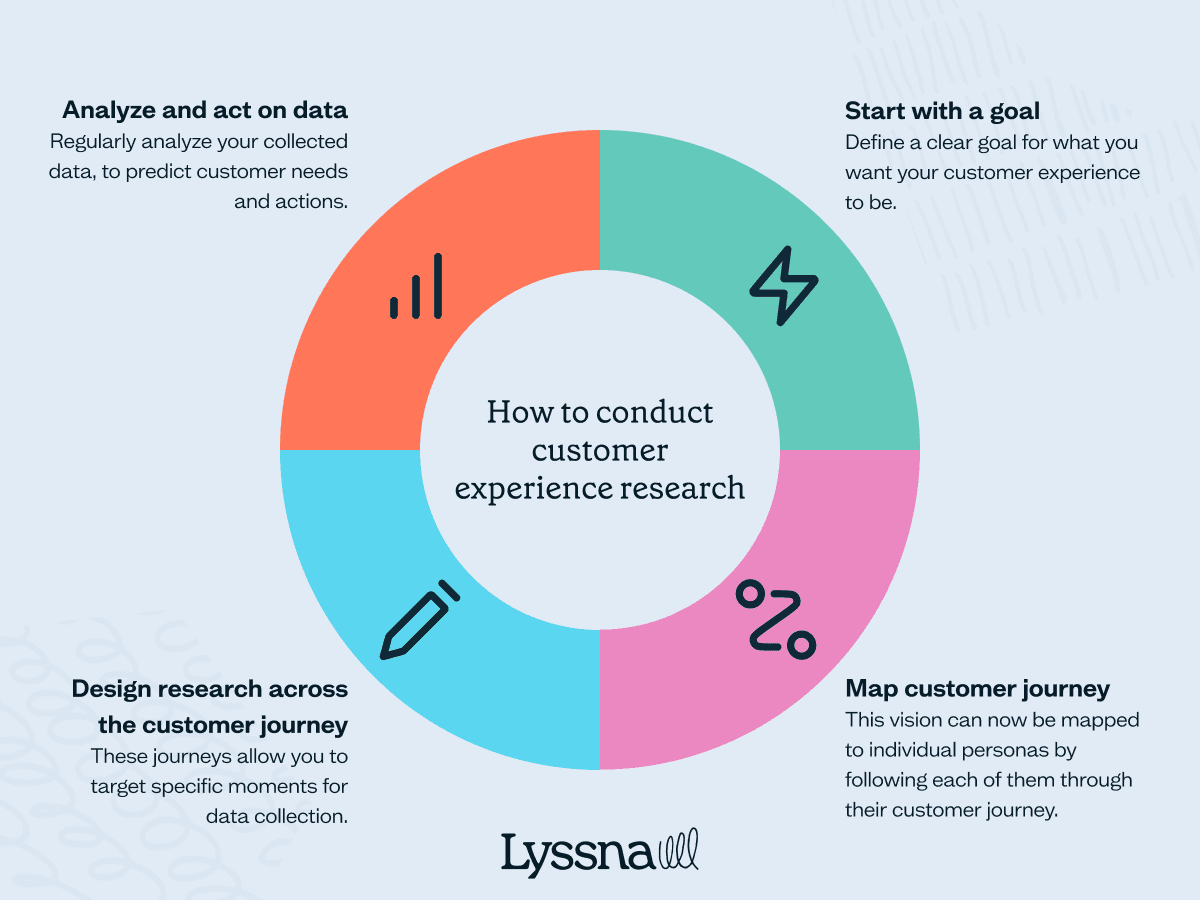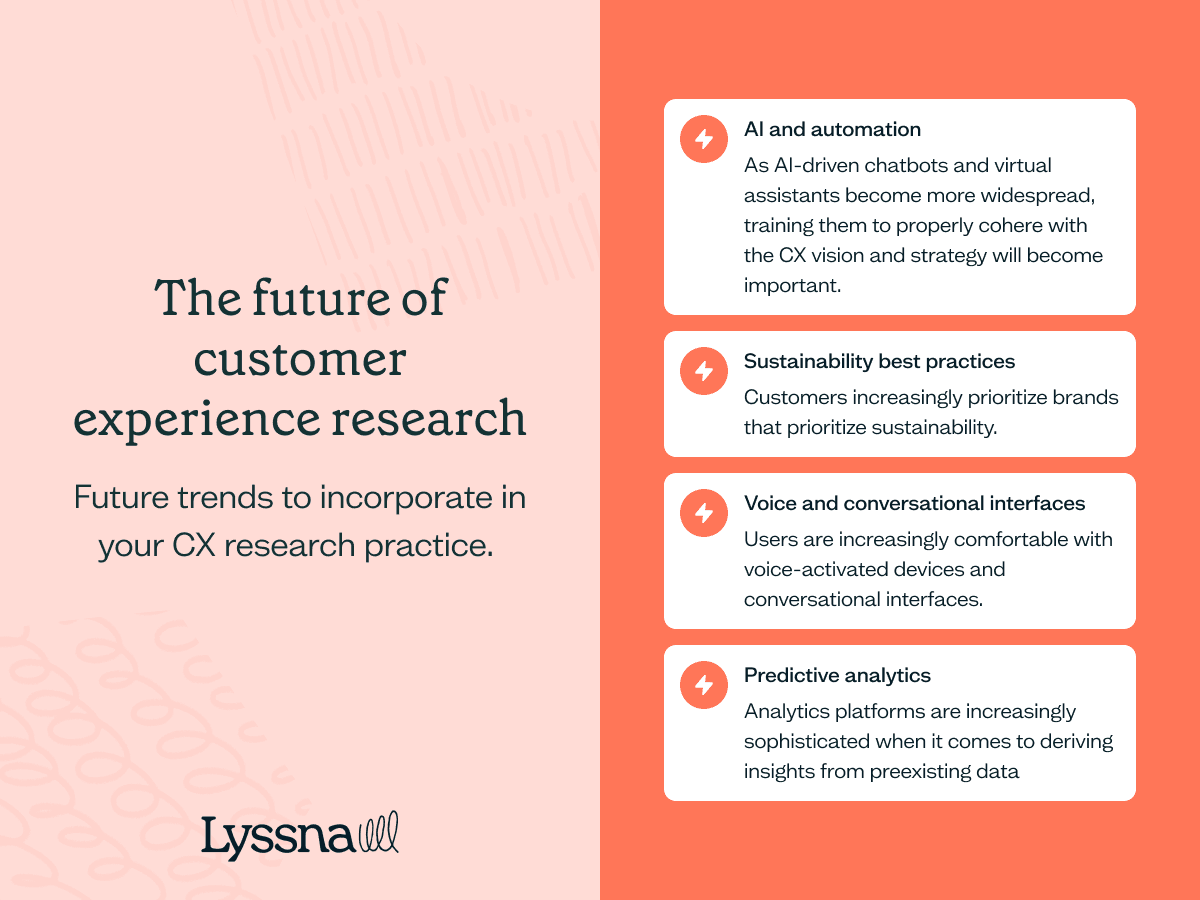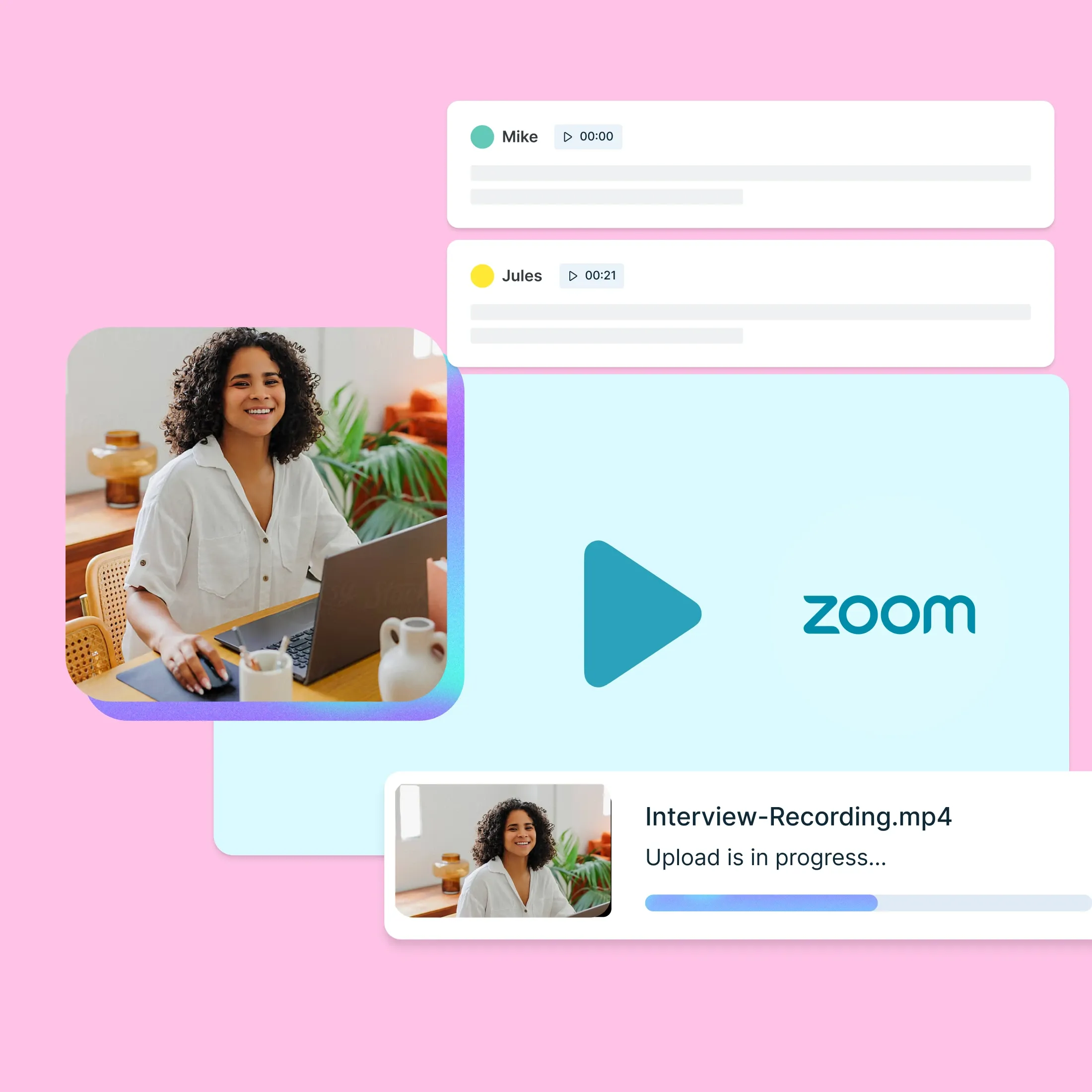10 Jun 2025
|18 min
What is customer experience (CX) research & how to do it in 2025
Get a complete overview of customer experience research, including tips, real-world examples, & recommended tools to collect better customer insights.

Key takeaways:
Customer experience (CX) research helps you understand how people interact with your brand across every touchpoint.
It includes methods like surveys, interviews, usability tests, behavioral analysis, and feedback review.
CX research supports customer retention, reduces costs, and improves brand reputation.
Common challenges include siloed data, recruitment issues, and turning insights into action – but they’re all solvable.
Platforms like Lyssna make CX research faster, easier, and more accessible for growing teams.
What is a business without customers? Probably a business that’s in trouble. It’s fairly obvious that businesses that focus on satisfying their customers thrive in the long run, but it’s worth considering this relationship as something more holistic than transactional.
For example, Microsoft’s research found that 90% of people believe customer service is important to their loyalty to a brand. And Salesforce found that some 80% of customers consider the experience a company provides to be as important as the products it provides.
So, what does that mean? That the customer experience (or CX) is worth dedicating time, resources, and serious contemplation toward. Even if you aren’t at a point in your company’s growth to devote a full department to CX and CX research, there’s still plenty to gain by learning more about the practice.
By viewing every interaction a customer has with your brand as part of a coherent, data-driven strategy, you can create the sort of relationship that turns curious shoppers into long-term advocates. And the root of good CX is good CX research.
Understanding customer experience research
Customer experience is the overall perception a customer has of your brand or business, encompassing all touchpoints and interactions throughout their customer journey, from awareness to advocacy.
CX encompasses not just the customer’s satisfaction with the product or service they purchased but also the quality of service throughout. It also covers their emotional connection to the experience as well as any troubleshooting or post-purchase interactions. Every email, phone call, and interaction with the user interface (UI) design helps build impression.
What is customer experience research?
Customer experience research, then, is the systematic process of gathering and analyzing data about customers’ interactions with the company across all touchpoints. When done correctly, customer research can help you gain insights into customer behavior, anticipate their needs, and reduce pain points.
Key components of customer experience research
A few key components of CX research to know include:
Understanding the user journey: CX research places enormous importance on the totality of the user journey, so mapping these and understanding how the phases impact each other is of high importance for researchers.
Collecting and analyzing customer feedback: CX research is rooted in empathizing with customers so you can better understand their needs and pain points and then find ways for your brand to fulfill or intercept them, respectively. This empathy is gained through extensive collection of feedback from real customers from methods including observational studies, focus groups, and design surveys.
The role of user personas: User personas, which are individual archetypes that stand in for the types of people who use a company’s products or services, guide CX research. Different personas may have different customer journeys and methods of communication, so they’ll need to be met in different ways, and possibly spoken to in different tones of voice.

Types of customer experience research
Customer experience research draws on multiple methods, each with its own strengths. Some help you understand what customers say, others reveal what they actually do. Used together, they offer a more complete view of the customer journey.
Customer surveys
Surveys are a quick, scalable way to test ideas, gather feedback on specific experiences, and understand customer preferences. They're especially useful for validating messaging or identifying friction points across the journey.
Lyssna lets you create custom surveys, recruit participants, and get results fast – all in one platform.
Use when: You want broad, quantitative insights across a large group of customers.
Customer interviews
Interviews allow you to explore customer motivations, expectations, and frustrations in depth. These one-on-one conversations can uncover nuances that structured surveys might miss.
Lyssna supports moderated interviews with flexible scheduling, participant targeting, and built-in tools for recording and analysis.
Use when: You need rich qualitative feedback to understand the “why” behind customer decisions.
Usability testing
Usability testing lets you observe how customers navigate a product or experience. It helps identify where users get confused, frustrated, or drop off, before those issues scale. With Lyssna, you can run unmoderated tests on prototypes or live products, then watch video replays to pinpoint friction points.
Use when: You want to evaluate how easy and intuitive a digital experience is to use.
Behavioral analytics
Behavioral research focuses on what customers do – not just what they say. It includes methods that capture real user actions, like where they click, how they navigate, and how they respond to visual elements.
With Lyssna, you can run first click tests to see where users instinctively go, and five second tests to capture their immediate impressions and recall, both offering fast, task-based behavioral data.
Use when: You’re optimizing conversion paths or diagnosing drop-offs in the user journey.
Customer feedback analysis
Analyzing open-text feedback from reviews, support tickets, or social media helps surface themes that structured data can overlook. It’s a powerful way to spot patterns and prioritize improvements.
Lyssna lets you collect this type of feedback through open-ended survey questions and user interviews.
Use when: You want to explore common pain points, requests, or moments of delight across touchpoints.
CX vs UX
If you’re coming from a user experience (UX) background, you may be wondering about the difference between CX and UX. It’s more than just semantic. They’re related but quite distinct disciplines that differ in some important ways, including:
Scope: CX encompasses the entire range of interactions and touchpoints a customer has with a brand or company, while UX focuses more on the design and usability of a specific product or system.
Focus: CX is more holistic, considering the customer’s overall journey and satisfaction with the brand as a whole, while UX concentrates more on the usability, UX accessibility, and efficiency of a single product or interface.
Touchpoints: CX involves all touchpoints, including marketing, customer support, and post-purchase experiences, while UX primarily deals with digital touchpoints, like websites, apps, and software.
There is some overlap. But while things like marketing and customer service can certainly impact a user’s overall experience, they’re more ancillary to the UX design and research process. CX wholeheartedly embraces every one of these interactions as something to be designed, measured, and refined through continuous product iteration.
Refine your customer experience with Lyssna
Leverage Lyssna’s powerful survey and interview tools to gauge sentiment and understand the "why" behind customer behaviors.
Why is customer experience research important
Given the breadth of its ambit, CX research can result in process improvements in practically any department. It may lead to new types of training for customer service or sales employees, or a dramatic rethinking of how to package and market certain products or services. These aren’t small projects.
But the focus on customer experience research can lead to business success in a number of ways, including:
Customer retention: Customer experience research helps retain customers by proactively identifying pain points and areas for improvement. According to Bain & Company, increasing customer retention rates by just 5% can lead to a 25% to 95% increase in profits.
Cost reduction: Harvard Business Review reports that it costs 5 to 25 times more to acquire a new customer than to retain an existing one. CX research helps address customer issues proactively, turning them into repeat buyers.
Brand reputation: CX research helps build a positive brand reputation. One survey by Trustpilot revealed that 88% of consumers trust online reviews as much as personal recommendations. By consistently delivering excellent customer experiences, brands can earn positive reviews and strengthen their reputation with potential customers.
Common challenges of customer experience research
Customer experience research has huge upside, but it’s not without hurdles. Here are some of the most common challenges teams run into, and how to navigate them effectively.
1. Siloed data across teams
Customer insights often live in different departments – marketing, support, product – making it hard to get a full picture of the experience. This fragmentation slows down decision-making and leads to missed opportunities.
Top tip: Start by mapping out where customer data currently lives. Create a shared CX research repository or dashboard that teams can contribute to and reference. Even a simple shared doc or Notion space can go a long way.
2. Difficulty recruiting the right participants
It’s hard to conduct meaningful research if you can’t reach the right people. Whether you're targeting new users, churned customers, or niche personas, getting relevant participants is a common blocker. Recruiting the right audience is also foundational to effective customer experience design – otherwise, you risk building around assumptions instead of reality.
Top tip: Use screeners to filter for specific criteria before someone enters a study. If you're struggling with sourcing, consider using a research panel like the one Lyssna offers to find verified participants that match your target audience.
3. Lack of stakeholder buy-in
Research can lose impact when stakeholders don’t understand its value, or they see it as “nice to have.” This often happens when research is presented in a way that feels abstract or disconnected from business goals. Framing insights in terms of their impact on UX and CRO can help bridge the gap between user needs and measurable outcomes.
Top tip: Present findings as stories, not just stats. Pull direct quotes, highlight clear customer pain points, and tie each insight to potential business impact. This helps stakeholders connect emotionally and practically to the research.
4. Measuring the wrong metrics
Relying too heavily on generic metrics (like NPS or page views) can give a false sense of clarity. They don’t always reveal why something is happening or what needs to change.
Top tip: Pair quantitative metrics with qualitative feedback. For example, follow up a score-based survey with open-ended questions or interviews. This helps you move from “what’s happening” to “why it’s happening.”
5. Turning research into action
Many teams generate great insights but struggle to turn them into clear next steps. Findings get lost in docs, deprioritized, or disconnected from product cycles.
Top tip: Build a feedback loop between research and delivery. That could mean running regular debriefs with product and design, or using tags to flag insights by feature or journey stage. Making research more actionable starts with embedding it into your workflow.
How to conduct customer experience research
One way to think about customer experience is as customer listening. It’s less flashy, but it’s a fine framework for thinking about instituting CX research practices in your company. Below, we’ll run through some ways to establish a structure to both listen to your customers and act on what they tell you.

1. Start with a goal
Start by defining a clear goal for what you want your customer experience to be. This should reflect your brand identity. What do you stand for? What is your “why”? What is the unique positioning statement? More importantly, what are the key experiences that will support your brand? Many of these answers probably already exist in branding documents and in the heads of key stakeholders.
If you’ve got a light, carefree product, like a game or a water-tracking app, that should determine the tone of these interactions. On the other hand, financial services software could look to project strength and institutional security. Or that financial services software might aim to be youthful and user-friendly. Either way, defining this “customer experience” vision in a statement or document can provide a north star for everything that follows.
2. Map the customer journey
This vision can now be mapped more concretely to individual personas by following each of them through their customer journey. While the various steps of the customer journey can vary, at a high level it always consists of:
Awareness: This is how customers become aware of your brand, product, or service, whether via organic search, word of mouth, or paid advertising.
Consideration: This is the period when customers evaluate their options, sometimes reading material on your site or reviews from third parties.
Purchase: Sometimes called a conversion, this is when customers make a decision and act.
Post-purchase experience: This encompasses both usage of the company as well as any engagement with support.
What are the key moments as they move down the funnel where the customer takes an action? How can that be designed intentionally? Map how each user persona might move through this journey and how they might ideally experience these moments. Many insights can be gained through in-depth interviews with real users here or observation of indirect feedback, like failed conversions.
3. Design research across the customer journey
These journeys – remember, there are likely variances between personas – allow you to target specific moments for data collection. You can seek direct feedback from users by asking them to complete a simple satisfaction survey after they complete purchases or customer service interactions. Always-on feedback mechanisms on your website or app can allow for highly detailed, in-the-moment reports of errors or frustrations. And observed behaviors, through the form of clickstream and point-of-sale data, can provide more intelligence.
Just remember that CX research is holistic – pinpointing one single interaction misses the forest for the trees. If you’re looking to improve ease-of-use for younger customers on the financial services software, focusing overwhelming on the conversion phase may ignore key learnings in the post-purchase support phase, when they need help getting set up or maintaining the software. The entire experience is your focus.
This can be accomplished by supplementing raw data with software that creates unified customer profiles or through more hands-on research methods, like user interviews.
4. Analyze and act on data
As you collect data across the customer journey, regularly analyze it to predict customer needs and actions. Where is churn occurring, and why? How can lapsed users be thoughtfully re-engaged? How can you fulfill needs or prevent pain points in a manner that prevents similar users from lapsing in the future?
For companies that want to let CX really drive decision-making, make sure there’s a smooth connection between CX research and business operations so that the insights can be acted on in real time. In smaller companies, this may just mean a regular meeting between the people in charge of CX research and those in charge of other arms of the company.
Either way, researchers themselves should look to communicate their analysis as cleanly as possible, creating charts to tell stories with the data and pulling quotes from users that will help other decision-makers really understand and empathize with the customers’ experiences.
Customer experience research methods
Proper utilization of CX research can transform the way a company operates. Fortunately, the tools for conducting this research are probably already at-hand for most companies with experience in user-centered design. Let’s run through a few of the key tools for CX research.
Interviews and focus groups: Quotes from real people provide invaluable qualitative data to support the more quantitative data derived from surveys. Understanding the difference between quantitative research vs qualitative research is crucial for researchers, as it informs both the kind of data collected and the analytical approach used. If you’re looking to explore different qualitative research types, methods like extensive one-on-one interviews or guided focus groups are great places to start. Even speaking with just five people can offer valuable insights and deepen customer empathy. If you're looking for ideas on how to structure these conversations, check out these user interview questions to guide your sessions effectively.
Observational studies: Watching customers can also help you understand their experience. In a brick-and-mortar operation, this may mean hanging out in the store and watching how customers shop and interact with employees. Online behavior can be analyzed through tools like click heatmaps and path analysis that provide unparalleled data about the use of both aggregate and single-session users.
Surveys: Surveys are a key method for checking the temperature of customers at key interactions. NPS (Net Promoter Score) is a common metric, asking users how likely they are to recommend the given product on a scale of 1 to 10.
Use our NPS survey template to collect valuable customer feedback and improve your product's perception and loyalty.
The future of customer experience research
Brands that center the customer experience will continue to look for new ways to do so. It’s worth looking ahead to some future trends to incorporate in your CX research practice.

AI and automation
As AI-driven chatbots and virtual assistants become more widespread, training them to properly cohere with the CX vision and strategy will become important. Similarly, AI will become more important at analyzing broad swaths of information, like social sentiment, email customer service, and chatbot interactions.
Sustainability best practices
Customers increasingly prioritize brands that prioritize sustainability. How will this trend impact their overall perception of your business, and how can a brand’s efforts in this regard be communicated in a way that improves the customer experience?
Voice and conversational interfaces
Users are increasingly comfortable with voice-activated devices and conversational interfaces. How can these technologies be incorporated in a manner that’s transparent but doesn't minimize your brand’s relatability?
Predictive analytics
Analytics platforms are increasingly sophisticated when it comes to deriving insights from preexisting data. Companies that can refine details about personas and user pathways based on extant data will hold an advantage over those that don't.
Collect better customer insights with Lyssna
Great customer experiences don’t happen by accident, they’re built on deep understanding. With Lyssna, you can uncover what real users think, feel, and do at every stage of the journey. From surveys to usability tests and interviews, our platform helps you make confident, research-backed decisions.
You may also like these articles


Try for free today
Join over 320,000+ marketers, designers, researchers, and product leaders who use Lyssna to make data-driven decisions.
No credit card required





